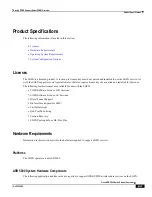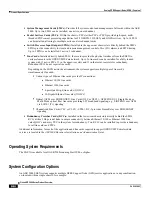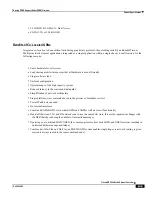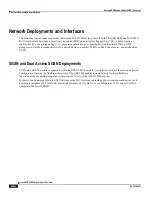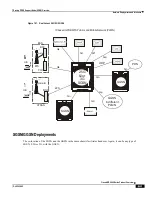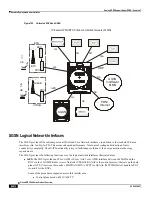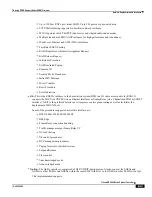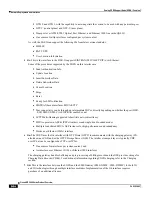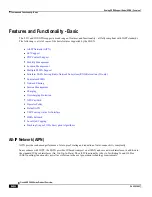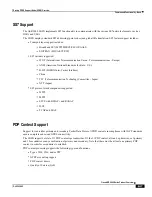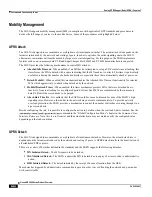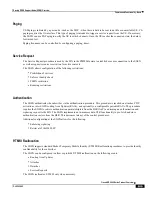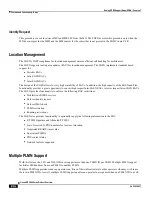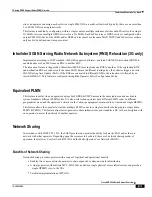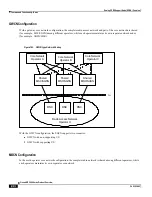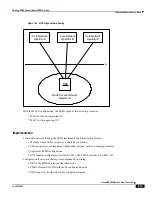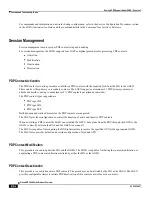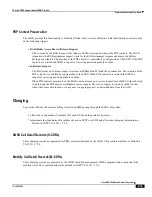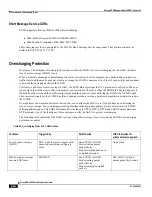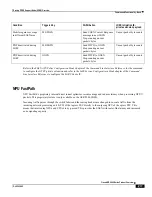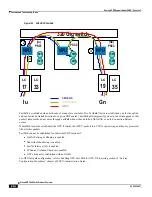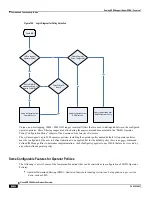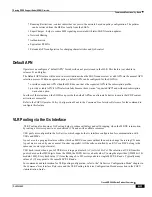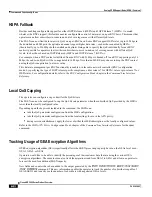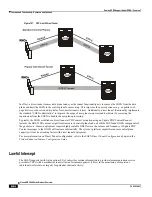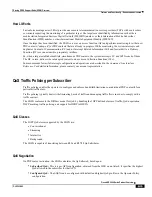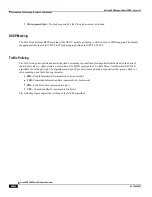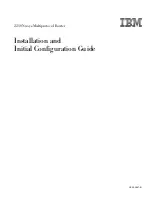
Serving GPRS Support Node (SGSN) Overview
Features and Functionality - Basic ▀
Cisco ASR 5000 Series Product Overview ▄
OL-22938-02
site or an operator can assign each cell-site a single PLMN ID in a multi-cell network (typically, there are no more than
3 or 4 PLMN IDs in a single network).
This feature is enabled by configuring, within a single context, multiple instances of either an IuPS service for a single
3G SGSN service or multiple GPRS services for a 2.G SGSN. Each IuPS service or GPRS service is configured with a
unique PLMN ID. Each of the SGSN and/or GPRS services must use the same MAP, SGTPU and GS services so these
only need to be defined one-time per context.
Intra/Inter SGSN Serving Radio Network Subsystem (RNS) Relocation (3G only)
Implemented according to 3GPP standard, the SGSN supports both inter- and intra-SGSN RNS relocation (SRNS) to
enable handover of an MS from one RNC to another RNC.
The relocation feature is triggered by subscribers (MS/UE) moving from one RNS to another. If the originating RNS
and destination RNS are connected to the same SGSN but are in different routing areas, the behavior triggers an intra-
SGSN Routing Area Update (RAU). If the RNS are connected to different SGSNs, the relocation is followed by an
inter-SGSN RAU. This feature is configured through the Operator Policy Configuration Mode.
Equivalent PLMN
This feature is useful when an operator deploys both GPRS & UMTS access in the same radio area and each radio
system broadcasts different PLMN codes. It is also useful when operators have different PLMN codes in different
geographical areas, and the operators‘ networks in the various geographical areas need to be treated as a single HPLMN.
This feature allows the operator to consider multiple PLMN codes for a single subscriber belonging to a single home
PLMN (HPLMN). This feature also allows operators to share infrastructure and it enables a UE with a subscription with
one operator to access the network of another operator.
Network Sharing
In accordance with 3GPP TS 23.251, the SGSN provides an operator the ability to share the RAN and/or the core
network with other operators. Depending upon the resources to be shared, there are 2 network sharing modes of
operation: the Gateway Core Network (GWCN) and the Multi-Operator Core Network (MOCN).
Benefits of Network Sharing
Network sharing provides operators with a range of logistical and operational benefits:
Enables two or more network operators to share expensive common network infrastructure.
A single operator with multiple MCC-MNC Ids can utilize a single physical access infrastructure and provide a
single HPLMN view to the UEs.
Facilitates implementation of MVNOs.
Summary of Contents for ASR 5000 Series
Page 1: ......
Page 26: ......
Page 48: ...New In Release 10 0 SCM Features Cisco ASR 5000 Series Product Overview OL 22938 02 ...
Page 50: ......
Page 58: ......
Page 68: ......
Page 126: ......
Page 138: ......
Page 146: ......
Page 218: ......
Page 236: ......
Page 356: ......
Page 374: ......
Page 422: ......
Page 496: ......
Page 572: ......
Page 654: ......
Page 700: ......
Page 726: ......
Page 784: ......
Page 816: ......
Page 844: ......
Page 906: ......
Page 926: ......
Page 942: ......
Page 943: ...Cisco ASR 5000 Series Product Overview OL 22938 02 Chapter 30 Technical Specifications ...
Page 966: ......
Page 972: ......

